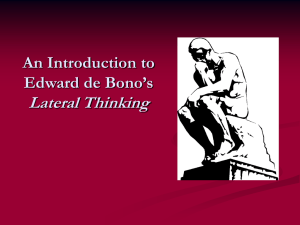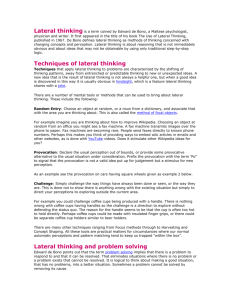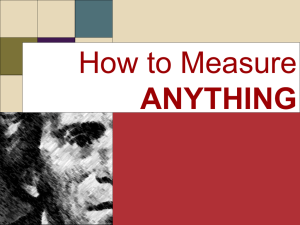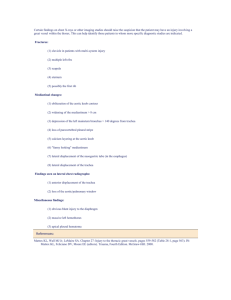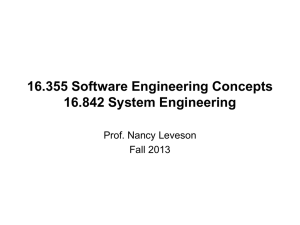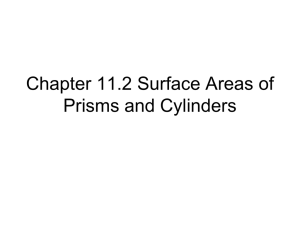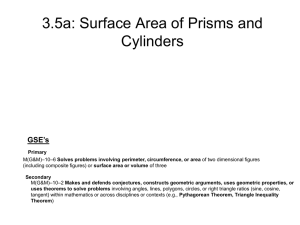N11-lat
advertisement
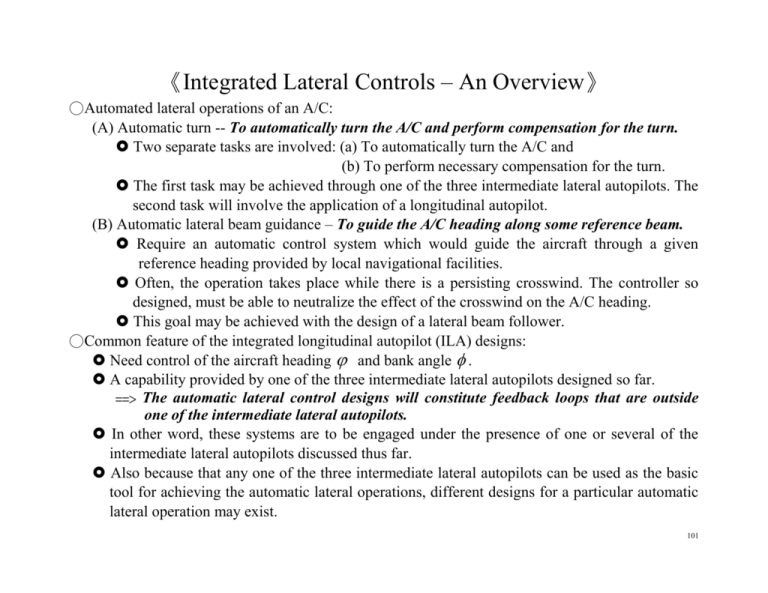
《Integrated Lateral Controls – An Overview》 ○Automated lateral operations of an A/C: (A) Automatic turn -- To automatically turn the A/C and perform compensation for the turn. Two separate tasks are involved: (a) To automatically turn the A/C and (b) To perform necessary compensation for the turn. The first task may be achieved through one of the three intermediate lateral autopilots. The second task will involve the application of a longitudinal autopilot. (B) Automatic lateral beam guidance – To guide the A/C heading along some reference beam. Require an automatic control system which would guide the aircraft through a given reference heading provided by local navigational facilities. Often, the operation takes place while there is a persisting crosswind. The controller so designed, must be able to neutralize the effect of the crosswind on the A/C heading. This goal may be achieved with the design of a lateral beam follower. ○Common feature of the integrated longitudinal autopilot (ILA) designs: Need control of the aircraft heading and bank angle . A capability provided by one of the three intermediate lateral autopilots designed so far. ==> The automatic lateral control designs will constitute feedback loops that are outside one of the intermediate lateral autopilots. In other word, these systems are to be engaged under the presence of one or several of the intermediate lateral autopilots discussed thus far. Also because that any one of the three intermediate lateral autopilots can be used as the basic tool for achieving the automatic lateral operations, different designs for a particular automatic lateral operation may exist. 101 《Integrated Lateral Controller for A Steady Turn》 ◎First task: To automatically turn the A/C◎ ○Feasible approaches for an A/C to achieve a coordinated turn: A turn maneuver may be performed manually by commanding, through the control stick, (a) a step rcom to a yaw orientation autopilot, or (b) a pulse com to a roll orientation autopilot A turn maneuver may also be performed automatically by providing (a) a step heading command com directly to the heading autopilot, or (b) a step heading error to the roll orientation autopilot through a feedback outer loop. ○Different aspects of the two automatic turn approaches: (a) The automatic turn maneuver which is executed through the heading autopilot may result in excessive yaw rate and thus necessitate a yaw rate limiter. On the other hand, the automatic turn maneuver performed with the roll orientation autopilot may result in excessive roll angle and thus necessitate a limitation of the roll angle. . (b) In a coordinated level turn (right figure), the lateral L av= g r . acceleration of the A/C will be ah= U0 U 0 r cos U 0 r Y . ah U 0 Equivalently, we also have ah g tan . --- In an automatic turn with the heading autopilot, Z where the maximum yaw rate is fixed by the limiter, the lateral acceleration of the turn will depend on the flight speed. --- In an automatic turn with the roll orientation autopilot, where the maximum roll angle is fixed by the limiter, the lateral acceleration of the turn is independent of the flight speed. 102 ◎Second task: Compensation for the turn on the pitch motion◎ ○About the turn compensation on the pitch motion: Compensation on the AOA of the A/C: L W = mg --- In a level turn, the aircraft banked to a roll angle . . and thus necessitate an increase in A.O.A. . mU0 to maintain the lift: L W cot W =====> r --- This need to increase the AOA is real, and can q be automatically compensated by an altitude Y hold autopilot, or be manually adjusted by the pilot through a step pitch angle command to the Z pitch orientation autopilot. Compensation in the pitching rate due to the turn: --- It is seen from the figure above that, in a steady level turn, a component of the heading rate, sin r tan , will be picked up by the pitching rate gyro. q --- This pitching rate signal due to a steady turn is superficial, it exists only because the gyro is installed in a non-inertial frame. --- Nevertheless, because this signal will be picked up by the pitching rate gyro and be feed back to the pitch orientation autopilot, an erroneous pitch motion will result, unless when proper counter action is taken. --- A proper counter action to remedy the problem is to issue a superficial pitch rate command to neutralize the superficial pitching rate signal picked up by the pitching rate gyro. --- The required superficial pitch rate command is in the amount of qref r tan which can be computed when the roll angle and the yaw rate r are known. --- Then, as the inertial reference frame is concerned, q remains zero during the turn. 103 《Integrated Controller for Lateral Beam Guidance》 ◎Geometry of lateral beam guidance◎ ○ Preliminaries on lateral beam guidance: Generally, an A/C is guided by pencil shaped directional RF transmission as heading reference Two kinds of transmission are generally employed: --- See Appendix A for detail (a) VOF or Omni ==> For mid way course guidance. (b) Localizer beam ==> For landing glide path guidance. ○Typical geometry of lateral beam guidance: Typical geometry of a N --- : angular error; 0 as shown lateral beam guidance --- d : distance off course; 0 as shown --- ref : interception angle (will be beam boundary negative when and d are 0 .) --- Geometrical relations: d (1) tan R d 57.3 R (2) d U 0 sin( ref ) U 0 ref- ref U0 d C L ref beam boundary R 57.3 ○Control objective: Nullify the angular error . --- will be measured in real-time Problem: We have no direct control over . --- But we have direct control over the heading angle . 57.3 1 d U o ( ref ) --- And from the above relations: R R Modify control objective: Eliminate through control of . 104 ◎Lateral beam follower – Some design guidelines◎ ○Generalized block diagram of a lateral beam follower: com= 0 ref The Coordinated A/C coupler com with lateral autopilot 1 1U Rs 0 Geometry will be measured in real-time by means of the proper navigational instrument.. The intermediate lateral autopilot employed will determine the structure of the coupler. --- In general, any of the three intermediate lateral autopilots can be used for this design. --- However, since a control of is the theme of the game here, a heading autopilot will be the primary candidate for the lateral beam following design. ==> Use of any other intermediate lateral autopilots for the design will require an additional feedback inner-loop to provide the heading control capability to the system. ○Coupler structure: The coupler must maintain the A/C on course even under the presence of a steady crosswind. --- A good disturbance rejection capability of the coupler is sought. --- This will imply an integrator feedback design. However, inclusion of an integrator in the coupler will lead to a double pole at s 0 , and causes these branches of the locus to move into the RHP, leaving no allowable solution. Feasible coupler structure: com ( s ) K sv ( s), v 1 s --- A zero at s v 0 is placed to pull the locus back into the LHP. --- The value of v will be determined through root locus analysis. 105 ◎Lateral beam follower –A design example◎ ○Conditions of the example design: Assume that a heading autopilot is used for the lateral beam following design The coordinated A/C dynamics identified in P.90 of this note is used here. ○ The A/C model – the closed-loop system of the heading autopilot: The coordinated A/C (see P.90 of this note): 1.76(s 8.41)( s 0.767)( s 1.97) 10 a ( s ), a ( s ) e a ( s ) s( s 4.427)( s 3.179)[ s 1.516 1.086i ]( s 0.017) s 10 s 0.1 The heading autopilot design: e ( s ) 0.2781.49 [ ( s ) ( s )] ( s ) com a s The following relation between and is obtained from the dynamics of the coordinated A/C: ( s) / ( s) 4.126s( s 4.49)[ s 1.73 0.745i] /[( s 8.41)( s 0.767)( s 1.97)] , ( s) As a result, the closed-loop system thus becomes: ( s) 7.29( s 0.1)( s 8.406)( s 1.967) com ( s ) ( s 0.175)( s 4.69)( s 10.26)[ s 0.34 0.34i ][ s 2.02 1.44i ] --- We have omitted a cancelled pole and zero pair at s 0.767 . ○Block diagram for the lateral beam follower design: U0 K R 7.29( s v )( s 0.1)( s 8.406)( s 1.967) s 2 ( s 0.175)( s 4.69)( s 10.26)[ s 0.34 0.34i ][ s 2.02 1.44i ] --- This diagram is for root locus analysis only; its input and output have been omitted. 106 ○Closed-loop system analysis: Often, a yaw limiter is installed in the heading autopilot, and the system is nonlinear in nature. --- However, a root locus analysis for linear systems is still adopted here --- Because of the non-linearity of the yaw command limiter, the final value of K can only be determined through trial on error simulation on the closed-loop system. 3 j 2 Solution at v = 0.13 and K = 0.085 R/U0 1 -10 -9 -8 -7 -6 -5 -4 -3 -2 1 -1 max K = 0.182 R/U0 -1 A 0 locus still applies -2 2 3 -3 A cluster of slow CL pole pairs, s -0.114 0.155i and s -0.109 0.125i , result; the CL response will be sluggish. --- The zeros at s -0.1 and at s -v can only suppress one pair of the slow CL poles. Because some branches of the locus (colored in pink) destabilizes so fast, we can not increase K to improve the solution ==>Note: K is expressed in terms of the multiple of R /U 0 107 ○Closed-loop system for simulations: Configurations of the lateral beam guidance systems for closed-loop simulation: com Limiter - s+v s e Coupler com rcom Limiter s+z - es z Equivalent yaw orientation aitopilot rcom Coordinated r 1K K e A/C with e s a x aileron servo Heading autopilot loop --- Two limiting circuits have been incorporated. --- The com (or com ) limiter is used to limit the value of . We have used the geometry: d U 0 sin( ref ) (ref ) U 0 / 57.3 This relation is valid, only if ref 0.6 rad . --- System will not converge when goes beyond 1 rad The pilot must fly the A/C so that the lateral beam follower is activated when ref 0.6 rad . Then, ref 0.6 rad . . --- The rcom limiter is installed to limit the peak value of . The yaw rate of the motion will be limited as a result. Limiting the yaw rate then reduces the bank angle. ref 1U Rs 0 1 s Geometry 1, so that Assuming com Limiter 0.6 com e Slope =1 -0.6 rcom Limiter 0.1 rcom es Slope =1 -0.1 108 ○Result of the closed-loop system simulations: 250U0 Beam boundary Station (t ) 2.5 Initial Crosswind ref Case 1 Case 2 Case 3 Case 4 2 2 1 2 0.2U0 0 0 0 Crosswind 0 10 0 0 In all cases, where the coupler was engaged at a distance equals 250 .times the flight speed , the A/C was back on course beyond a range of 150 .times the flight speed. --- Because the coupler gain is a function of R /U 0 , all distances in relation to this simulation were expressed in terms of the multiple of the flight speed. Because the beam intercept geometry is nonlinear, convergence of the simulation will depend on the starting values of and R . --- For a that starts from 2 , a converging result exists only if R 300U0 from the t 0 . A large R /U 0 implies a large K , hence a sensitive beam intercept feedback loop. If compounded with a large , the initial drive on will be large, thereby enhancing the nonlinear geometry, and prohibits the convergence of the system. --- The use of com limiter does allow us to start from R 600U 0 , for the same initial . However, the rcom limiter must be turned off, and the bank angle becomes unacceptable. For a early engagement of the coupler, the pilot must maneuver the A/C to reduce the initial 109 ◎ More on the simulation result ◎ ○The role of the two nonlinear limiting circuits: Because of the com limiter, a (t ) 0.6, t ; resulted, and a linear beam intercept geometry is maintained. (The top right figure shows the worst case of the four cases simulated.) --- Because the controllability of the system, d U 0 cos( ref ) , will become small for 1 rad . 0.6 0.4 Data from Case 2 (t) 0.2 0 -0.2 -0.4 -0.6 0 0.6 0.4 50 100 150 200 Data from Case 2 0.2 0 (t) The rcom limiter, however, limits the bank angle -0.4 -0.6 0 50 100 150 200 within a 30 degree range. (The lower figure) ○ The problem of the varying loop gain with a changing flight distance R : : From the root locus analysis, we have set a design point at KU0 / R 0.085 . --- If we fix K at K 0.085R / U0 for a particular speed U 0 and a particular initial distance R0 ,, then the loop gain of the system, KU0 / R , will vary as R decreases. --- Because the locus may turn unstable for K U 0 / R 0.182 , the coupler may not work properly when R R0 0.085 / 0.182 . We will either reduce K or turn off the coupler. In a landing condition, the localizer station is located at the far end of the run way such that the A/C would always maintain a safe distance to the station and no instability problem exists. During mid course guidance, we may need to disengage the coupler when the A/C is too close to the Omni station. -0.2 110
